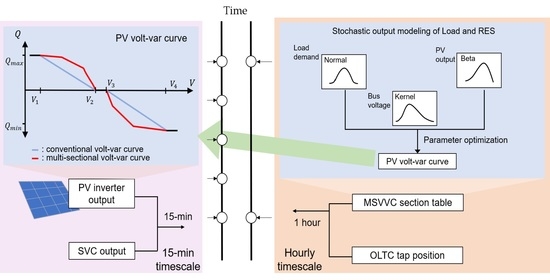Stochastic Analysis-Based Volt–Var Curve of Smart Inverters for Combined Voltage Regulation in Distribution Networks
Abstract
1. Introduction
- A new multi-sectional volt–var curve (MSVVC) of the PV inverter which follows the IEEE 1547 standard [10] is proposed. The MSVVC section table is updated by the main controller in the hourly timescale for the objective of network expected energy loss minimization, and the inverters operate along the MSVVC in the 15 min timescale.
- To manage the uncertainty of the load demand and the RES output, parameters of the MSVVC were determined using the Monte Carlo-based stochastic analysis and non-linear optimization.
- Using the active control of reactive power output in PV inverters, other reactive power compensators (i.e., SVCs) can obtain an operational margin. The proposed method can cope with more severe voltage issues than the conventional method.
- The proposed method helps the RES inverter generate or absorb more reactive power than the conventional method, which, in turn, leads to network voltage profile improvement. Thus, the bus voltage in the distribution network can be kept within the allowed margin, even when the load demand and RES power outputs fluctuate.
2. Proposed Methodology
2.1. Stochastic Modeling of Load Demand and RES Generation
2.2. Proposed Multi-Sectional Volt–Var Curve of PV Inverter
2.3. Volt–Var Control Framework with Multi-Sectional Volt–Var Curve
- Stochastic modeling of load demand and PV output considering the uncertainty and intermittency nature is applied. The load demand and PV output follow normal and beta distribution, respectively.
- Through the load flow analysis for the load demand and PV output data, voltage distribution is generated and fitted through kernel density function as presented in Figure 4.
- The x-coordinate values of MSVVC (i.e., , , and ) are determined. To determine the x axis values, PV inverters do not compensate reactive power. They are defined by the probability and as shown in Equations (15) and (16). Moreover, the voltage with the maximum probability is defined to the mode value .
- Through the proposed optimization process, the y coordinate values of MSVVC (i.e., reactive power output of PV inverter) are determined. The objective function is to minimize the total expected energy loss with following the several constraints as described in Equations (9)–(14). Through a series of processes, the MSVVC section table is generated every hour.
- The DMS generates the MSVVC section table and regulates OLTC tap position every hour. Then, PV inverters compensate reactive power with MSVVC in the 15 min timescale. Moreover, SVCs compensate reactive power to maintain PCC voltages as 1.0 p.u.
3. Case Studies
3.1. Stochastic Model
3.2. Parameter Settings
3.3. Simulation Results
4. Discussion
5. Conclusions
Author Contributions
Funding
Institutional Review Board Statement
Informed Consent Statement
Data Availability Statement
Conflicts of Interest
References
- Sewdien, V.; Chatterjee, R.; Escudero, M.V.; Van Putten, J. System Operational Challenges from the Energy Transition. Cigre Sci. Eng. 2020, 17, 5–19. [Google Scholar]
- Moon, W.S.; Hur, J.; Kim, J. A Protection of interconnection transformer for DG in Korea distribution power system. In Proceedings of the 2012 IEEE Power and Energy Society General Meeting, San Diego, CA, USA, 22–26 July 2012; pp. 1–5. [Google Scholar] [CrossRef]
- Yun, S.Y.; Hwang, P.I.; Moon, S.I.; Kwon, S.C.; Song, I.K.; Choi, J.H. Development and Field Test of Voltage VAR Optimization in the Korean Smart Distribution Management System. Energies 2014, 7, 643–669. [Google Scholar] [CrossRef]
- Hwang, P.; Jeong, M.; Moon, S.; Song, I. Volt/Var optimization of the Korean smart distribution management system. In Proceedings of the 22nd International Conference and Exhibition on Electricity Distribution (CIRED 2013), Stockholm, Sweden, 10–13 June 2013; pp. 1–4. [Google Scholar] [CrossRef][Green Version]
- Reno, M.J.; Broderick, R.J. Statistical analysis of feeder and locational PV hosting capacity for 216 feeders. In Proceedings of the 2016 IEEE Power and Energy Society General Meeting (PESGM), Boston, MA, USA, 17–21 July 2016; pp. 1–5. [Google Scholar] [CrossRef]
- Abbey, C.; Baitch, A.; Bak-Jensen, B.; Carter, C.; Celli, G.; El Bakari, K.; Fan, M.; Georgilakis, P.; Hearne, T.; Ochoa, L.N.; et al. Planning and Optimization Methods for Active Distribution Systems; International Council on Large Electric Systems (CIGRE): Paris, France, 2014. [Google Scholar]
- Resener, M.; Rebennack, S.; Pardalos, P.; Haffner, S. Handbook of Optimization in Electric Power Distribution Systems; Springer International Publishing: Berlin/Heidelberg, Germany, 2020. [Google Scholar] [CrossRef]
- Ustun, T.S.; Hashimoto, J.; Otani, K. Impact of Smart Inverters on Feeder Hosting Capacity of Distribution Networks. IEEE Access 2019, 7, 163526–163536. [Google Scholar] [CrossRef]
- Hatziargyriou, N.; Milanović, J.; Rahmann, C.; Ajjarapu, V.; Cañizares, C.; Erlich, I.; Hill, D.; Hiskens, I.; Kamwa, I.; Pal, B.; et al. Stability Definitions and Characterization of Dynamic Behavior in Systems with High Penetration of Power Electronic Interfaced Technologies; IEEE: Piscataway Township, NJ, USA, 2020. [Google Scholar]
- IEEE Standard for Interconnection and Interoperability of Distributed Energy Resources with Associated Electric Power Systems Interfaces; IEEE Std 1547–2018 (Revis. IEEE Std 1547–2003); IEEE: Piscataway Township, NJ, USA, 2018; pp. 1–138. [CrossRef]
- Bründlinger, R. Review and Assessment of Latest Grid Code Developments in Europe and Selected International Markets with Respect to High Penetration PV. In Proceedings of the 6th Solar Integration Workshop, Vienna, Austria, 15–17 November 2016. [Google Scholar]
- Italian Standard; CEI. CEI 0–16. In Reference Technical Rules for the Connection of Active and Passive Consumers to the HV and MV Electrical Networks of Distribution Company; CEI: Milano, Italy, 2008. [Google Scholar]
- Italian Standard; CEI. CEI 0–21. In Reference Technical Rules for Connecting Users to the Active and Passive LV Distribution Companies of Electricity; CEI: Milano, Italy, 2011. [Google Scholar]
- Antoniadou-Plytaria, K.E.; Kouveliotis-Lysikatos, I.N.; Georgilakis, P.S.; Hatziargyriou, N.D. Distributed and Decentralized Voltage Control of Smart Distribution Networks: Models, Methods, and Future Research. IEEE Trans. Smart Grid 2017, 8, 2999–3008. [Google Scholar] [CrossRef]
- Kekatos, V.; Zhang, L.; Giannakis, G.B.; Baldick, R. Voltage regulation algorithms for multiphase power distribution grids. IEEE Trans. Power Syst. 2015, 31, 3913–3923. [Google Scholar] [CrossRef]
- Ghosh, S.; Rahman, S.; Pipattanasomporn, M. Distribution Voltage Regulation Through Active Power Curtailment with PV Inverters and Solar Generation Forecasts. IEEE Trans. Sustain. Energy 2017, 8, 13–22. [Google Scholar] [CrossRef]
- Zhu, H.; Liu, H.J. Fast Local Voltage Control Under Limited Reactive Power: Optimality and Stability Analysis. IEEE Trans. Power Syst. 2016, 31, 3794–3803. [Google Scholar] [CrossRef]
- Maciejowski, J.; Goulart, P.; Kerrigan, E. Constrained Control Using Model Predictive Control. In Advanced Strategies in Control Systems with Input and Output Constraints; Springer: Berlin/Heidelberg, Germany, 2007; pp. 273–291. [Google Scholar] [CrossRef]
- Qin, S.; Badgwell, T.A. A survey of industrial model predictive control technology. Control Eng. Pract. 2003, 11, 733–764. [Google Scholar] [CrossRef]
- Bidgoli, H.S.; Van Cutsem, T. Combined local and centralized voltage control in active distribution networks. IEEE Trans. Power Syst. 2017, 33, 1374–1384. [Google Scholar] [CrossRef]
- Takasawa, Y.; Akagi, S.; Yoshizawa, S.; Ishii, H.; Hayashi, Y. Effectiveness of updating the parameters of the Volt-VAR control depending on the PV penetration rate and weather conditions. In Proceedings of the 2017 IEEE Innovative Smart Grid Technologies-Asia (ISGT-Asia), Auckland, New Zealand, 4–7 December 2017; pp. 1–5. [Google Scholar]
- Dao, V.T.; Ishii, H.; Hayashi, Y. Optimal parameters of volt-var functions for photovoltaic smart inverters in distribution networks. IEEJ Trans. Electr. Electron. Eng. 2019, 14, 75–84. [Google Scholar] [CrossRef]
- Rylander, M.; Reno, M.J.; Quiroz, J.E.; Ding, F.; Li, H.; Broderick, R.J.; Mather, B.; Smith, J. Methods to determine recommended feeder-wide advanced inverter settings for improving distribution system performance. In Proceedings of the 2016 IEEE 43rd Photovoltaic Specialists Conference (PVSC), Portland, OR, USA, 5–10 June 2016; pp. 1393–1398. [Google Scholar] [CrossRef]
- Lee, H.J.; Yoon, K.H.; Shin, J.W.; Kim, J.C.; Cho, S.M. Optimal parameters of volt–var function in smart inverters for improving system performance. Energies 2020, 13, 2294. [Google Scholar] [CrossRef]
- Niknam, T.; Zare, M.; Aghaei, J. Scenario-based multiobjective volt/var control in distribution networks including renewable energy sources. IEEE Trans. Power Deliv. 2012, 27, 2004–2019. [Google Scholar] [CrossRef]
- Wang, Z.; Wang, J.; Chen, B.; Begovic, M.M.; He, Y. MPC-based voltage/var optimization for distribution circuits with distributed generators and exponential load models. IEEE Trans. Smart Grid 2014, 5, 2412–2420. [Google Scholar] [CrossRef]
- Fabbri, A.; Roman, T.G.; Abbad, J.R.; Quezada, V.M. Assessment of the cost associated with wind generation prediction errors in a liberalized electricity market. IEEE Trans. Power Syst. 2005, 20, 1440–1446. [Google Scholar] [CrossRef]
- Korea Power Exchange. Available online: http://kpx.or.kr (accessed on 6 November 2020).
- Xu, Y.; Dong, Z.Y.; Zhang, R.; Hill, D.J. Multi-timescale coordinated voltage/var control of high renewable-penetrated distribution systems. IEEE Trans. Power Syst. 2017, 32, 4398–4408. [Google Scholar] [CrossRef]
- Baran, M.E.; Wu, F.F. Network reconfiguration in distribution systems for loss reduction and load balancing. IEEE Power Eng. Rev. 1989, 9, 101–102. [Google Scholar] [CrossRef]

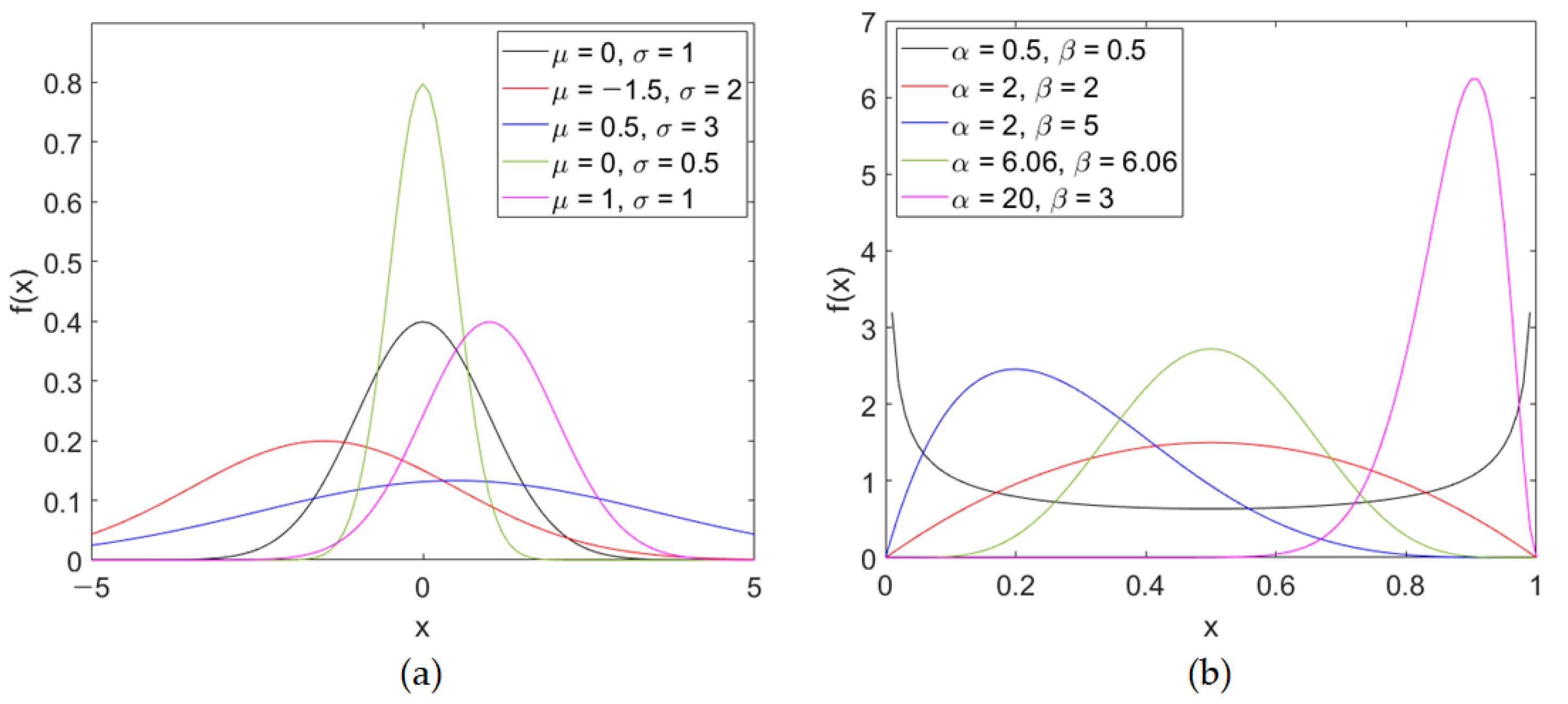
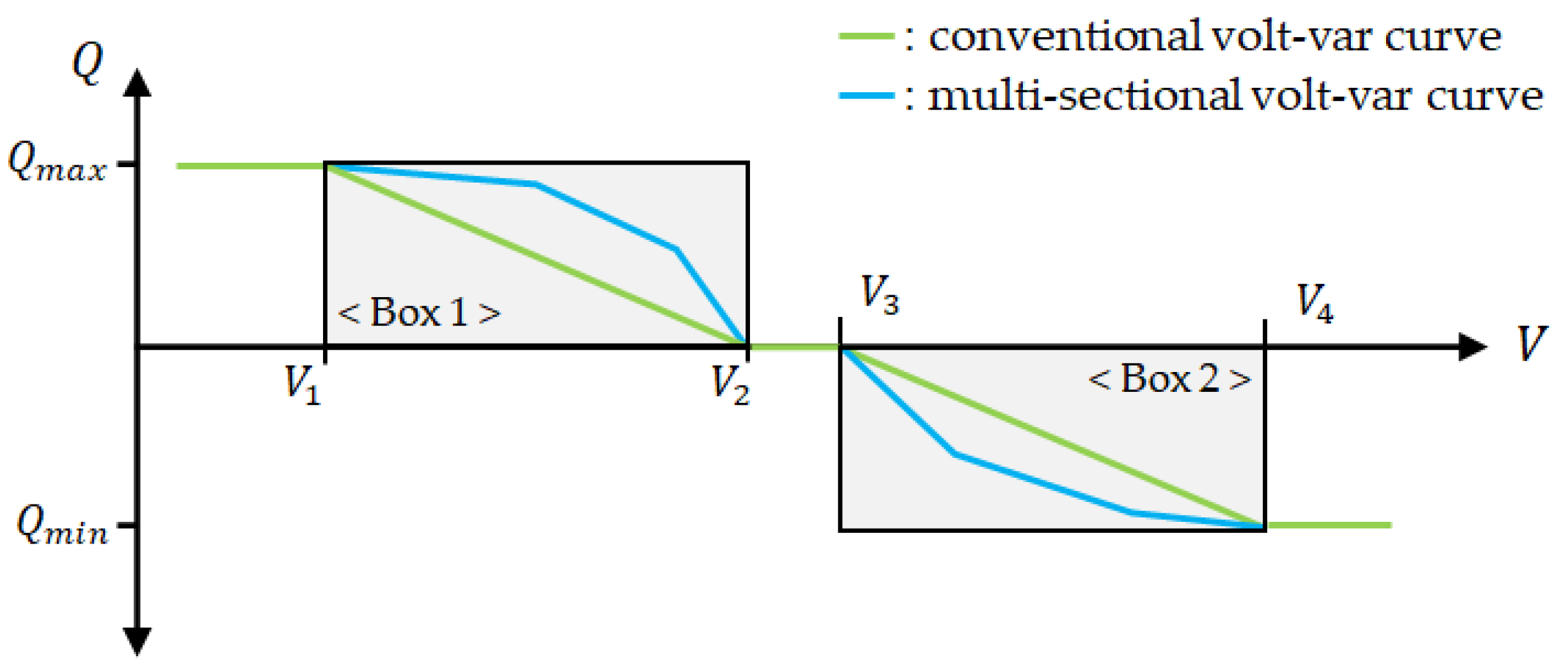
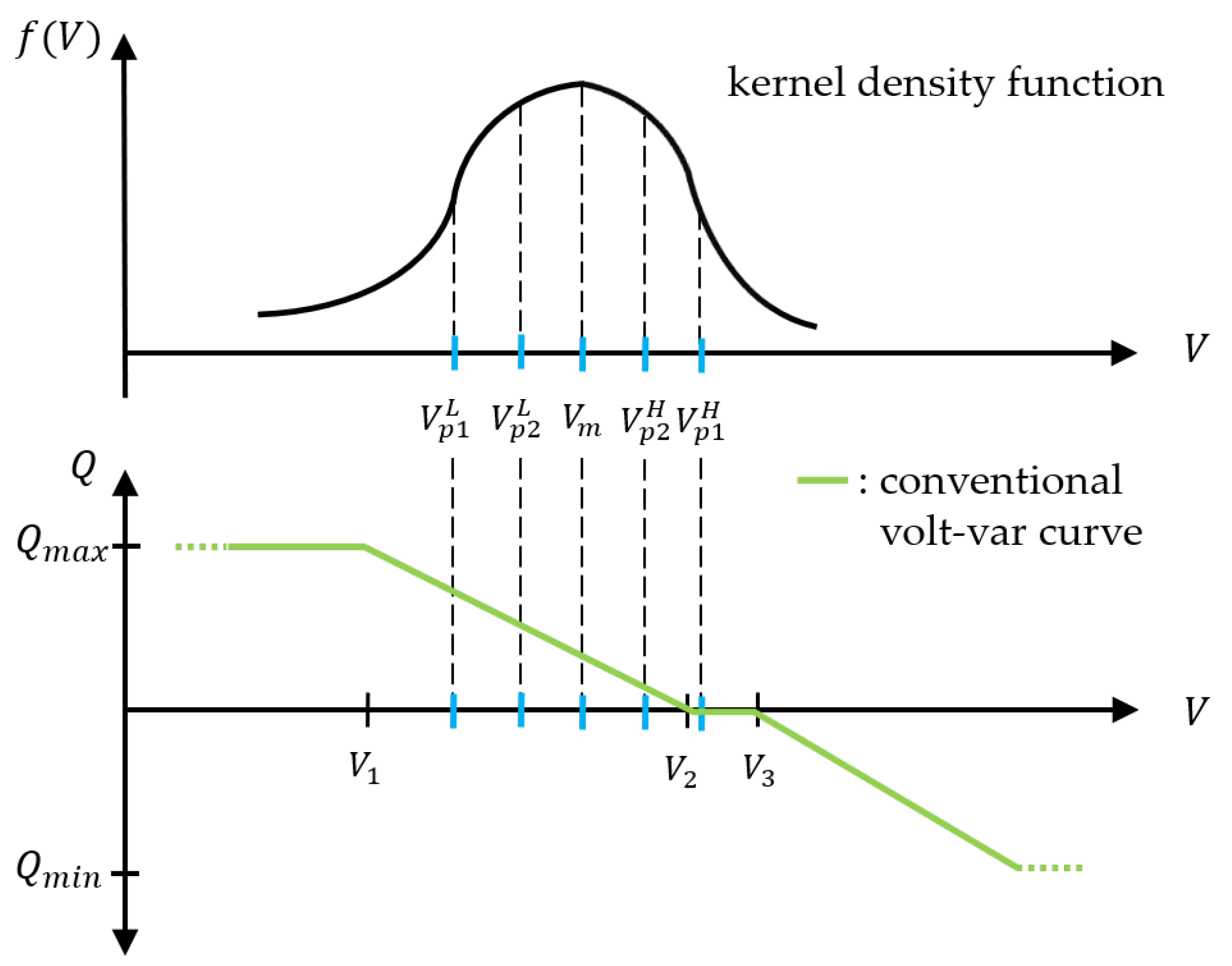
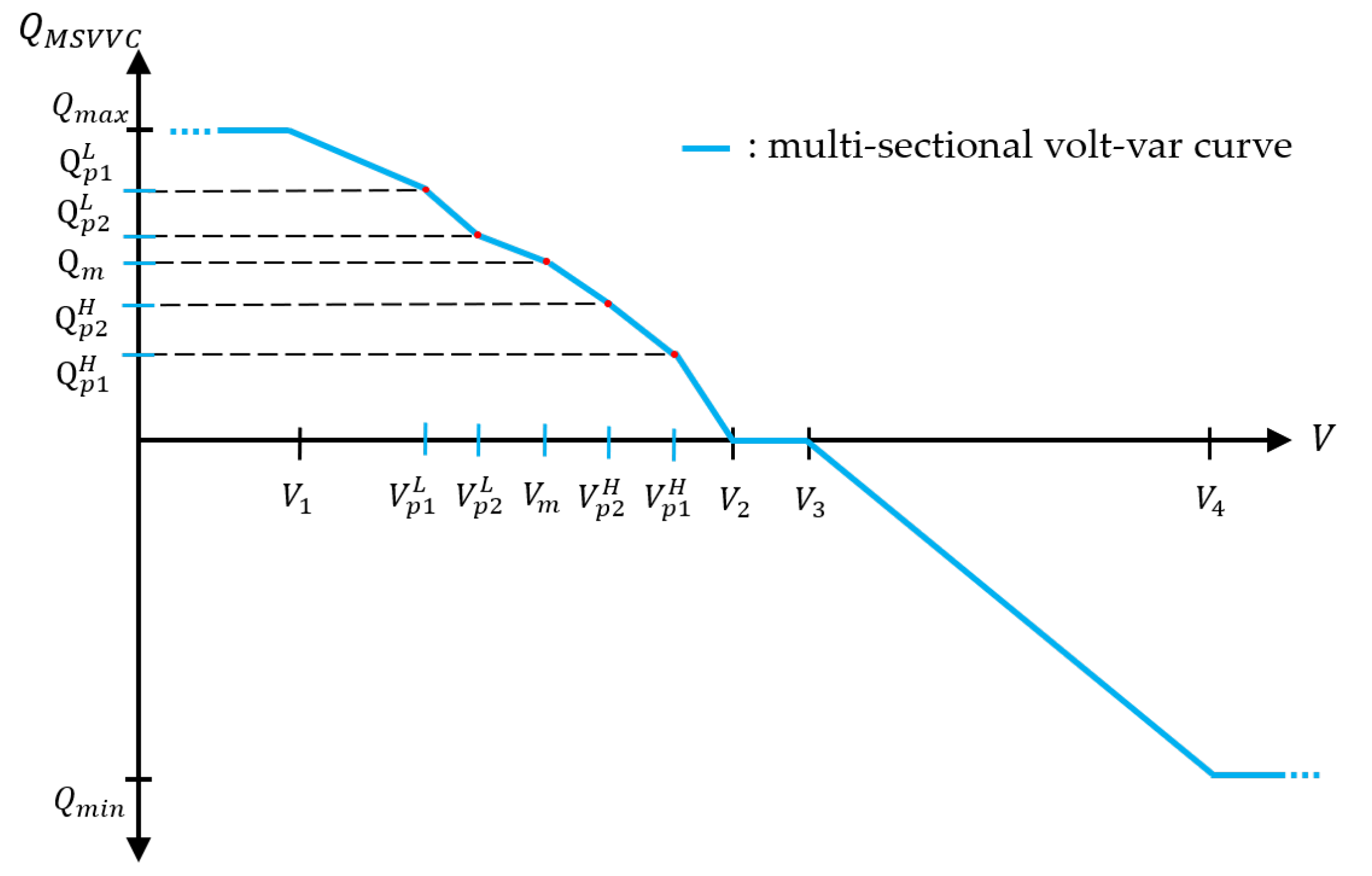
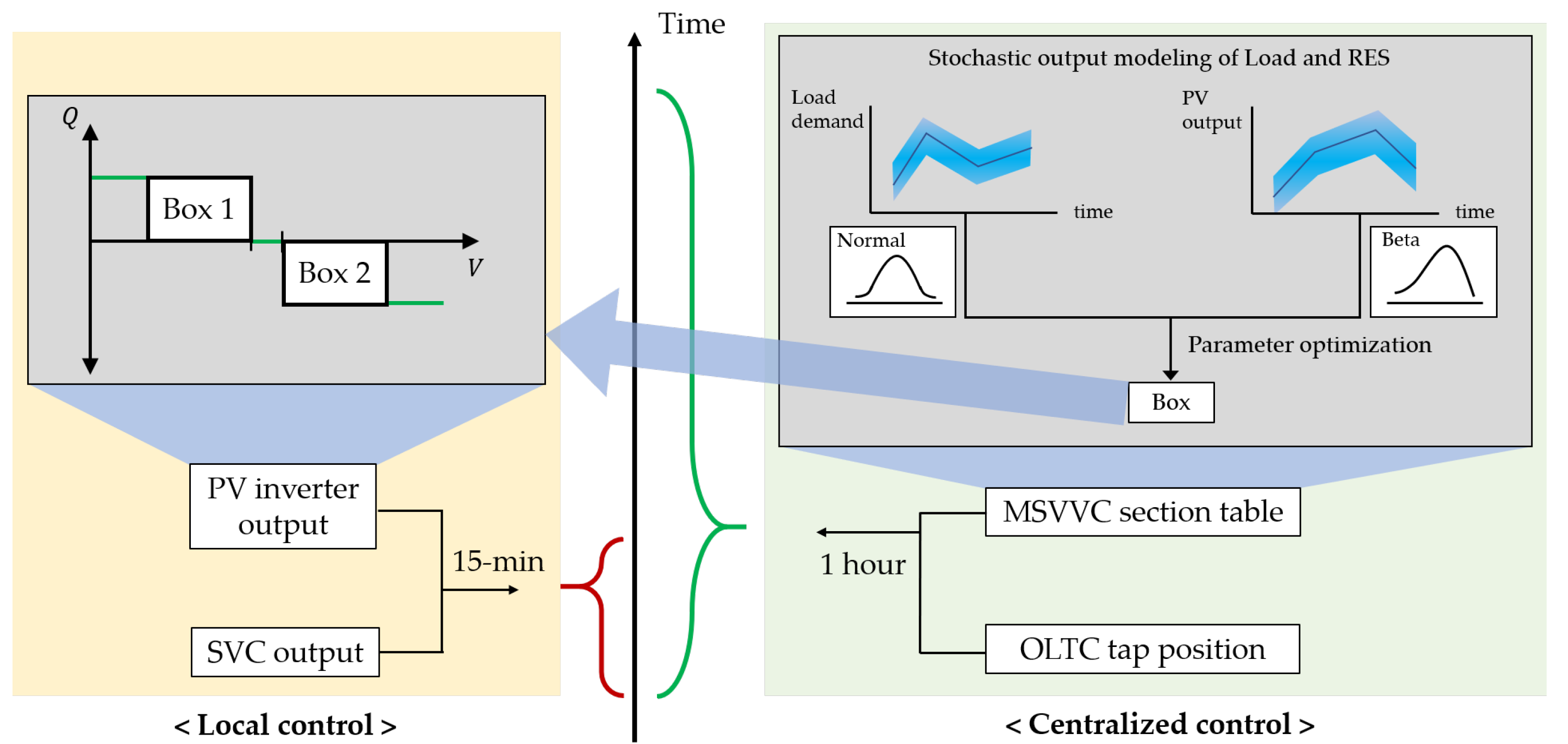
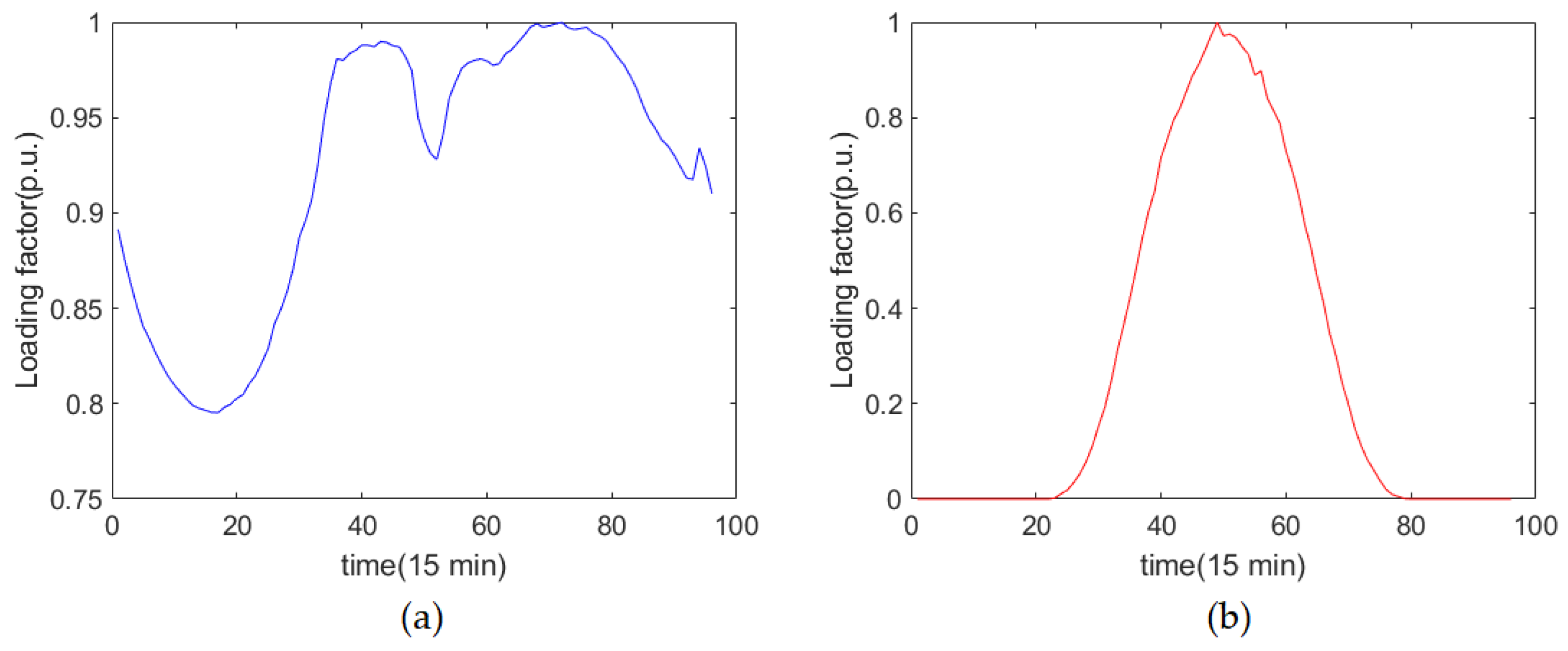


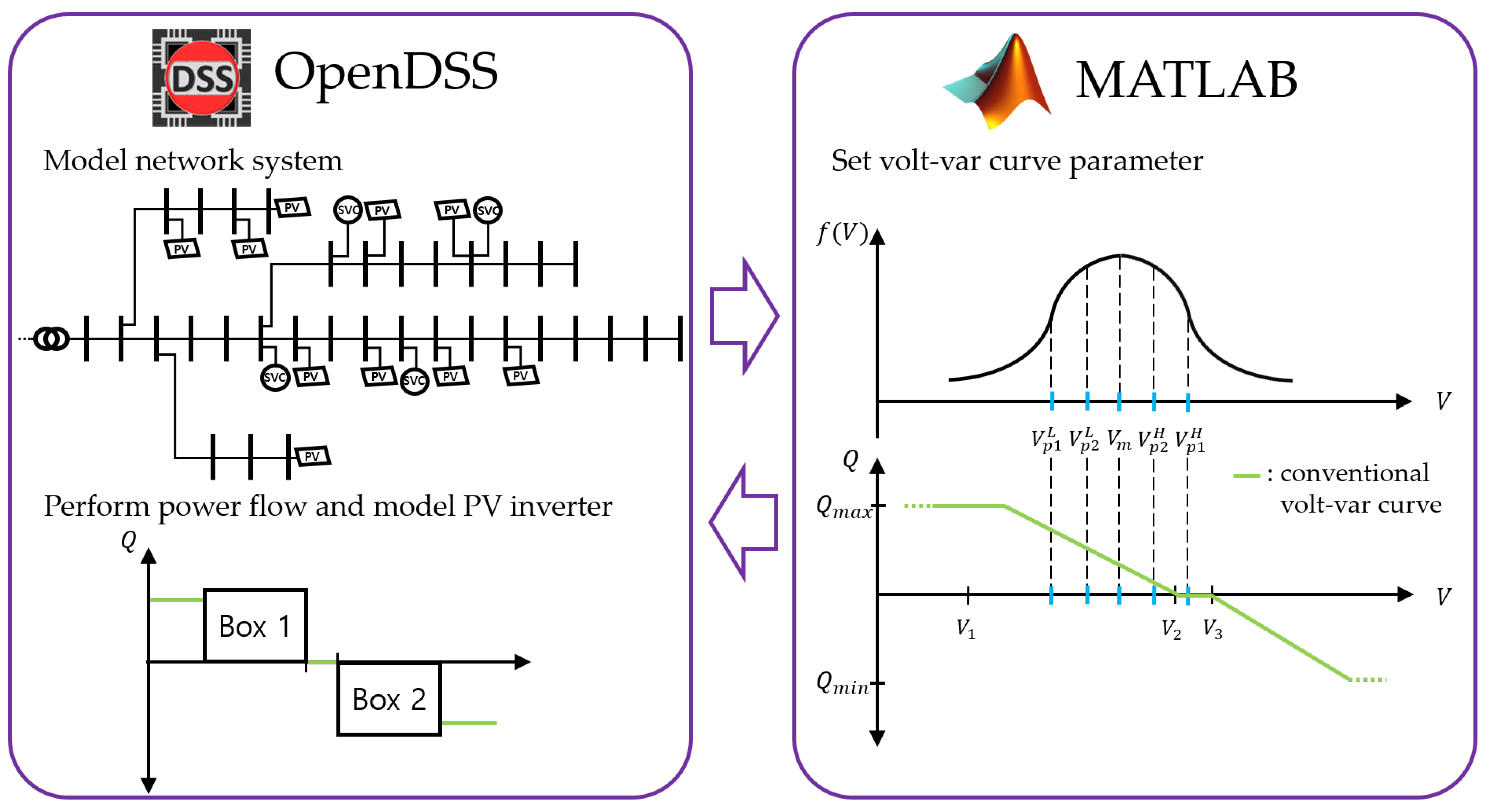



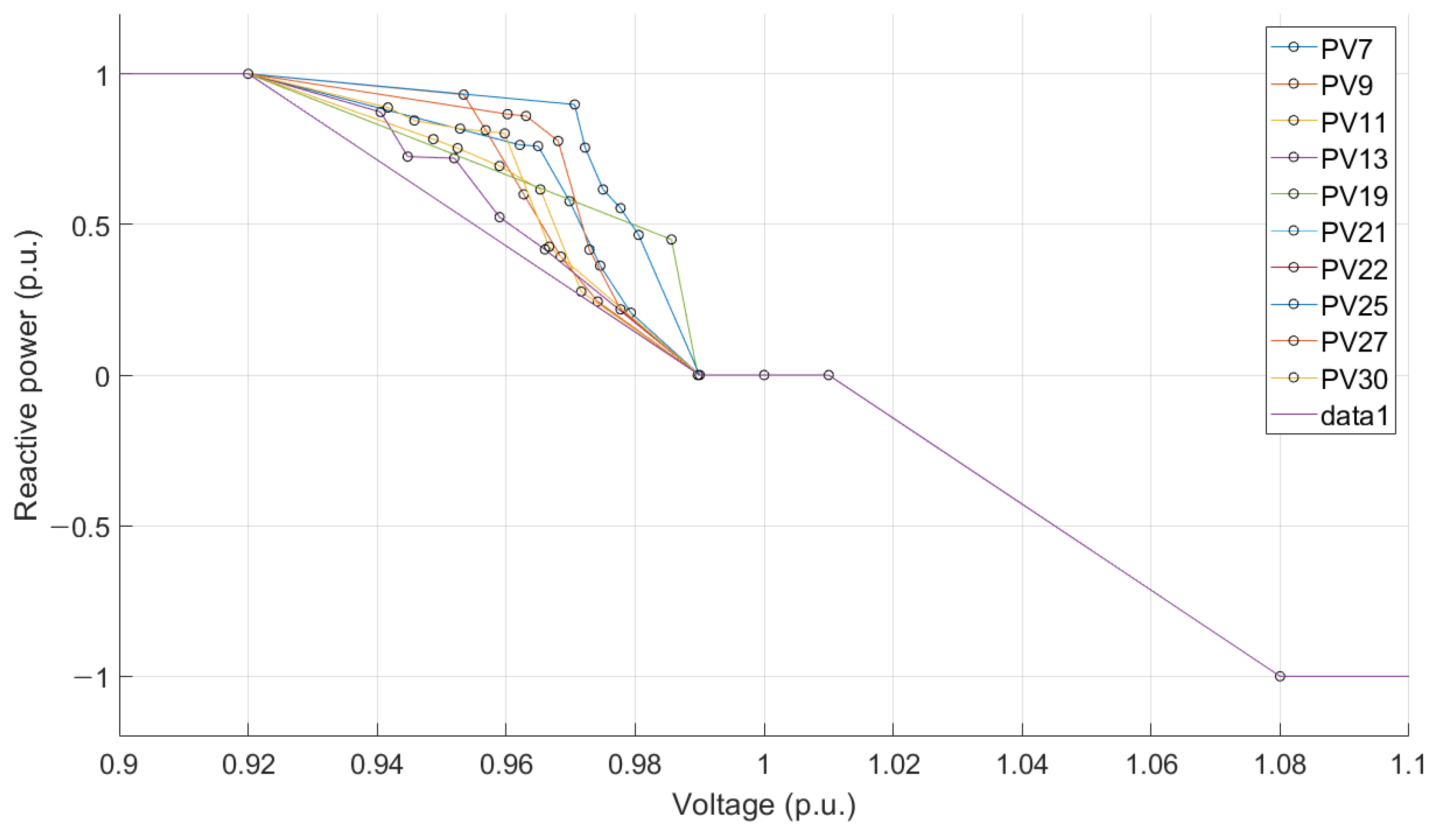
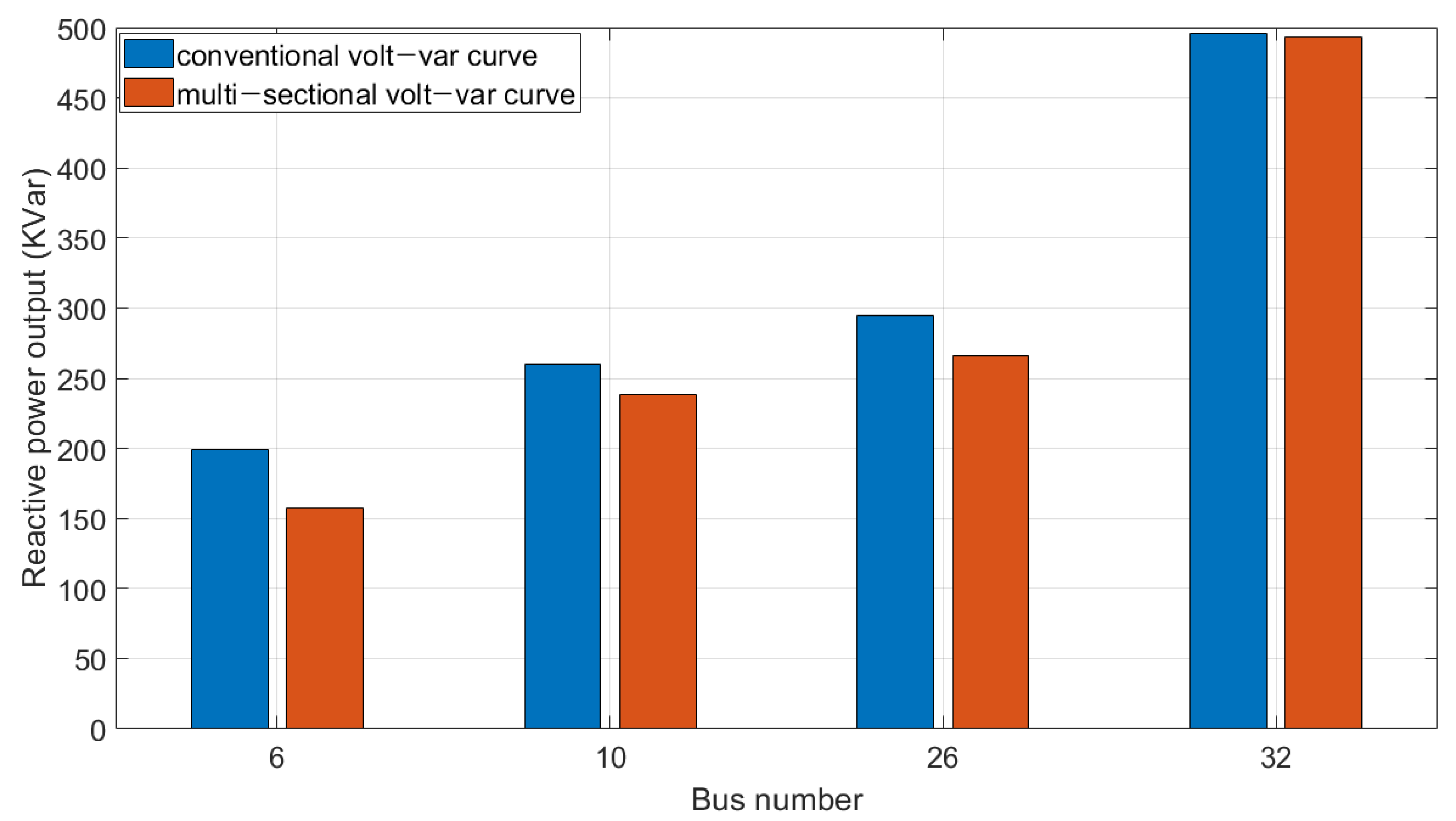
| PV Inverter | SVC | ||
|---|---|---|---|
| Location (Node) | 7, 9, 11, 13, 19, 21, 22, 25, 27, 30 | 6, 10, 26, 32 | |
| Capacity | S (KVA) | 824 | ±500 |
| Maximum P (KW) | 700 | - | |
| Case 1 | Case 2 | Case 3 | |
|---|---|---|---|
| MIN voltage (p.u.) | 0.9504 | 0.9446 | 0.9505 |
| MAX voltage (p.u.) | 1.0383 | 1.0383 | 1.0381 |
| Average VPI | 3.5156 | 3.4678 | 3.3086 |
| Case 1 | Case 2 | Case 3 | |
|---|---|---|---|
| Expected energy loss (KWh) | 99.039 | 85.774 | 82.175 |
| Voltage violation | No | Yes | No |
| SVC output (KVarh) | 670.57 | 1001.4 | 954.71 |
Publisher’s Note: MDPI stays neutral with regard to jurisdictional claims in published maps and institutional affiliations. |
© 2021 by the authors. Licensee MDPI, Basel, Switzerland. This article is an open access article distributed under the terms and conditions of the Creative Commons Attribution (CC BY) license (https://creativecommons.org/licenses/by/4.0/).
Share and Cite
Lee, D.; Han, C.; Jang, G. Stochastic Analysis-Based Volt–Var Curve of Smart Inverters for Combined Voltage Regulation in Distribution Networks. Energies 2021, 14, 2785. https://doi.org/10.3390/en14102785
Lee D, Han C, Jang G. Stochastic Analysis-Based Volt–Var Curve of Smart Inverters for Combined Voltage Regulation in Distribution Networks. Energies. 2021; 14(10):2785. https://doi.org/10.3390/en14102785
Chicago/Turabian StyleLee, Dongwon, Changhee Han, and Gilsoo Jang. 2021. "Stochastic Analysis-Based Volt–Var Curve of Smart Inverters for Combined Voltage Regulation in Distribution Networks" Energies 14, no. 10: 2785. https://doi.org/10.3390/en14102785
APA StyleLee, D., Han, C., & Jang, G. (2021). Stochastic Analysis-Based Volt–Var Curve of Smart Inverters for Combined Voltage Regulation in Distribution Networks. Energies, 14(10), 2785. https://doi.org/10.3390/en14102785






